Classic Moussaka Recipe
Moussaka is a classic Greek comfort food recipe that is reminiscent of lasagna; a spiced ground beef mixture is layered with eggplant, potatoes, and cheese, all smothered in a rich bechamel sauce. A warm and cozy dish, variations are found all over Europe; it’s perfect for holidays, special dinners, and winter nights in.
Years ago, I visited my husband (then-boyfriend) when he was living just outside of Washington DC. A few blocks from his apartment was a small Greek restaurant with a menu that overwhelmed and excited me. Being totally unsure of what to choose, I asked him for a suggestion, followed it, and ordered their moussaka.
Similar to lasagna or a layered casserole, this traditional Mediterranean dish has sliced eggplant and potato rather than noodles. Between the layers are bites of spiced beef and creamy bechamel sauce. There are so many rich flavors and exciting textures, I couldn’t stop thinking about it for days. A few years after having it for the first time, I worked hard to find a recipe that gave me the same warm feeling – and this is it!
As I’ve said, this originated in Greece but there are variations of it all over the world. In Albania, Bulgaria, and other countries of the region, they use all potatoes, and the topping is more of a custard than a bechamel. In Egypt, they use only eggplant and often eat it cold, or after being in the refrigerator overnight. Turkey does things differently, serving it more like a stew, alongside rice.
What is so wonderful about all of these different traditions, is that you can make lots of variations based on what you and your family love, as well as what you may have available!
Ingredients for moussaka
This moussaka has a robust flavor, thanks to layer upon layer of different tastes and textures. This is how we build it:
- Eggplant and Potatoes: I use both in this recipe, as is standard in the Greek versions. However, you can go all potatoes or all eggplant, if you’d like. I have even seen versions with zucchini and carrots as well.
- Meat: In this recipe, I choose spiced beef, again the more traditional option. However, plenty of versions include lamb and some even choose to go with ground turkey or chicken. Of course, for those who want to go meatless, any of the many plant-based ground/crumbled “beef” options will work well, though you may need to adjust cooking time based on their packaging.
- Dairy: This recipe does call for eggs, cheese, milk, and butter. Any plant-based option can be swapped here, but the thicker and richer your cream and butter the better! Plant-based egg replacements work fairly seamlessly, but be sure to find something to swap for both the egg whites and egg yolk in this recipe, since they both play a part.
- Spices and Pantry Items: Beyond the meat, dairy, and veggies, the rest of the recipe calls for a lot of staple items. Though I love a swap that saves you time – please keep the ground nutmeg and allspice added as written. These spices are so key to the incredibly rich beef flavor and I would love for you to experience that the first time you try this!
How to make moussaka step-by-step
- Peel and slice your eggplant into 1/2 inch rounds. Sprinkle them with salt and line them in a colander. They will drain here for one hour before you take it out to pat them dry and squeeze out any excess water softly. Once patted dry, set the slices aside. Peel and slice your potatoes into 1/2 inch rounds as well, putting them aside to be layered in later.
- Heat a saucepan with olive oil, and once hot cook the eggplant slices for six to eight minutes, turning occasionally until they are browned on both sides. Drain pieces on a paper towel-lined baking sheet or plate.
- After removing the eggplant, add more oil to the pan, along with garlic and onion. Once softened, reduce the heat to medium and add in ground beef, stirring until browned.
- Once the meat is browned, add the tomato, allspice, sugar, and salt and pepper. Simmer until the liquid has evaporated, and remove to cool. Once cooled, fold in the egg whites and parsley.
- Next, get started on the bechamel sauce. First, pour milk into a saucepan and bring to a barely boil before taking off the heat. Melt the butter in a large pan and add flour, stirring for one minute. Remove the pan from heat, and whisk in the milk until the mixture is totally smooth. Add the pan back onto the stovetop and simmer on medium for 10-15 minutes, or until thick and smooth. Take it off of the heat one more time, and fold in nutmeg, salt, and pepper.
- Preheat your oven to 400 degrees F. Grease a 10×15 inch lasagna pan with butter, and sprinkle with bread crumbs.
- Now we begin assembly! Line the base of the pan with potato slices, overlapping them slightly. Cover with half of the beef and tomato mixture, and sprinkle with half of the parmesan and half of the remaining breadcrumbs.
- Begin the second layer by lining with eggplant slices, also overlapped. Top that with the remaining half of the beef, parm, and breadcrumbs.
- Whisk the heavy cream and egg yolks into the cooled bechamel sauce, and spread it evenly over the top of the dish. It’s okay if this layer is thick!
- Bake for 50 minutes, or until the top is lightly browning. Let it stand for about 15 minutes before diving in!
Serving suggestions
Moussaka is eaten in a million different ways – even cold! At restaurants, you will often find it served with a cold cucumber salad, green beans, or crispy garlic bread. A side salad or pasta salad would also be a great side to this versatile main course.
Making ahead and storing moussaka
Just like a casserole or lasagna, moussaka is a great dish to bring to gatherings, send to a busy friend, or have ready to go on a busy weekday night!
- Make-Ahead: Assemble the moussaka, cover, and refrigerator for up to 1 day, but store the bechamel sauce stored separately in the refrigerator. Whisk the bechamel sauce vigorously; if it is too thick to pour, reheat in a saucepan over low heat until it reaches a pouring consistency. Pour over the prepared moussaka and bake as directed.
- Freezing: Because the white sauce does not freeze especially well, make and layer the eggplant, potatoes, and meat mixture, then cover with aluminum foil and freeze for up to 3 months. Thaw in the refrigerator, then make the bechamel, add it to the top, and bake as directed.
- Storing Leftovers: The moussaka can be kept covered in the refrigerator for up to 5 days.
More delicious Greek recipes
- Greek Lamb Gyros with Tzatziki
- Galaktoboureko (Greek Custard Pie)
- Koulourakia (Greek Easter Cookies)
- Pastisio Recipe (baked ziti and meat sauce)
I would absolutely love it if you made this Moussaka; if you do, please stop back and leave a rating and let me know how you liked it! ENJOY! 😍
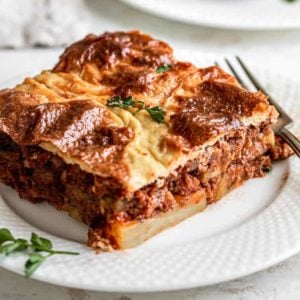
Moussaka
Ingredients
- 2¼ pounds (1020 g) eggplant, peeled and cut into ½-inch rounds
- ½ cup (108 ml) olive oil
- 1 yellow onion, grated
- 2 garlic cloves, sliced
- 2 pounds (907.18 g) lean ground beef
- 16 ounces (453.59 g) tomato puree
- ¼ teaspoon (0.25 teaspoon) ground allspice
- ½ teaspoon (0.5 teaspoon) granulated sugar
- Salt and pepper
- 1 egg white, lightly beaten
- 5 tablespoons finely chopped fresh parsley
- 5 tablespoons plain breadcrumbs
- 1 cup (100 g) grated Parmesan cheese
- 2¼ pounds (1.02 kg) russet potatoes, peeled and cut into ½-inch rounds
For the White Sauce:
- 3 cups (732 ml) whole milk
- 3 tablespoons unsalted butter
- 3 tablespoons all-purpose flour
- ¼ teaspoon (0.25 teaspoon) ground nutmeg
- Salt and white pepper, to taste
- 5 tablespoons heavy cream
- 3 egg yolks, lightly beaten
Instructions
- Sprinkle the eggplant slices with salt and let drain in a colander for 1 hour. Rinse, squeeze out any excess water and pat dry.
- Heat ¼ cup of the olive oil in a large saute pan over medium heat. Add the eggplant and cook, turning occasionally, for 6 to 8 minutes, or until lightly browned on both sides (if you don't have a pan big enough, do this in two batches). Remove from the pan with a slotted spoon or spatula and drain on paper towels.
- Reduce the heat to low and add the remaining ¼ cup of olive oil to the pan. Add the onion and garlic and cook, stirring occasionally, for about 5 minutes, or until the onion is softened. Increase the heat to medium, add the ground beef and cook, stirring and breaking up the meat with a spoon, for about 10 minutes, or until browned. Add the tomato puree, allspice, and sugar, and season with salt and pepper. Reduce the heat and simmer for 15 to 20 minutes, or until all the liquid has evaporated. Remove from heat and let cool, then fold in the egg white and parsley.
- Meanwhile, prepare the white sauce. Place the milk in a small saucepan and bring to barely a boil, then remove from the heat. Melt the butter in a large, heavy skillet over medium heat, then stir in the flour and cook, stirring frequently, for 1 minute. Remove the pan from the heat and gradually pour in the hot milk, whisking constantly until the mixture is smooth. Return the sauce to medium heat and simmer, whisking constantly, for 10 to 15 minutes, until thickened and smooth. Remove from the heat, and whisk in the nutmeg, salt and pepper.
- Preheat oven to 400 degrees F. Grease a 10x15-inch lasagna pan with butter and sprinkle with 2 tablespoons of the bread crumbs. Cover the base of the dish with the potato slices, overlapping them slightly. Spread half of the meat mixture on top and sprinkle with half of the Parmesan cheese and 2 tablespoons of the remaining bread crumbs. Cover with the eggplant slices, overlapping them slightly. Spread the remaining meat mixture on top, sprinkle with the remaining Parmesan cheese and the remaining breadcrumbs. (At this point, the dish may be covered and frozen. Thaw before baking.)
- Whisk the cream and egg yolks into the white sauce and spread it evenly over the surface of the dish. Bake for about 50 minutes, or until the top is golden brown. Remove from the oven and let stand for 15 minutes before serving.
Notes
- Potatoes and Eggplant: I use a combination in this recipe, but you can use all potatoes or all eggplant. You can also substitute zucchini or carrots.
- Serving Suggestions: Add garlic bread or a side salad to round this out as the main course.
- Make-Ahead: Assemble the moussaka, cover, and refrigerator for up to 1 day, but store the bechamel sauce stored separately in the refrigerator. Whisk the bechamel sauce vigorously; if it is too thick to pour, reheat in a saucepan over low heat until it reaches a pouring consistency. Pour over the prepared moussaka and bake as directed.
- Freezing: Because the white sauce does not freeze especially well, make and layer the eggplant, potatoes, and meat mixture, then cover with aluminum foil and freeze for up to 3 months. Thaw in the refrigerator, then make the bechamel, add it to the top, and bake as directed.
- Storing Leftovers: The moussaka can be kept covered in the refrigerator for up to 5 days.
- Recipe adapted from Vefa's Kitchen
Did you make this recipe?
Leave a review below, then snap a picture and tag @thebrowneyedbaker on Instagram so I can see it!
Photography by Julia Trigo.


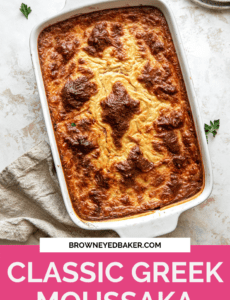
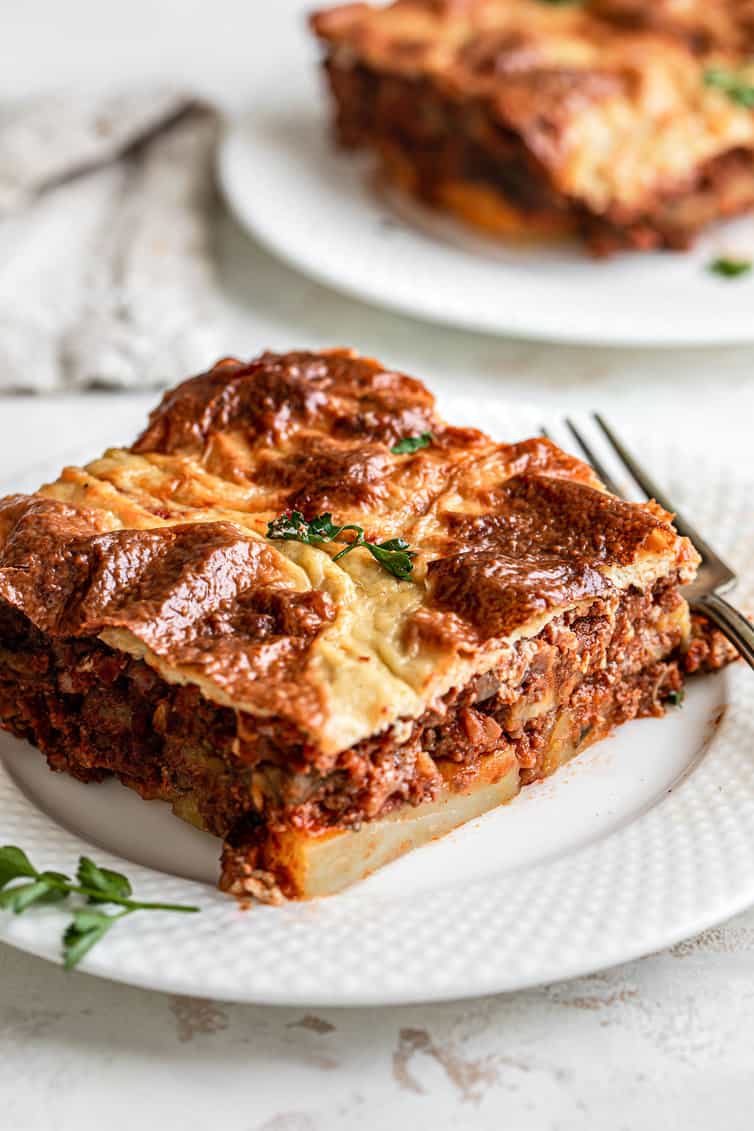
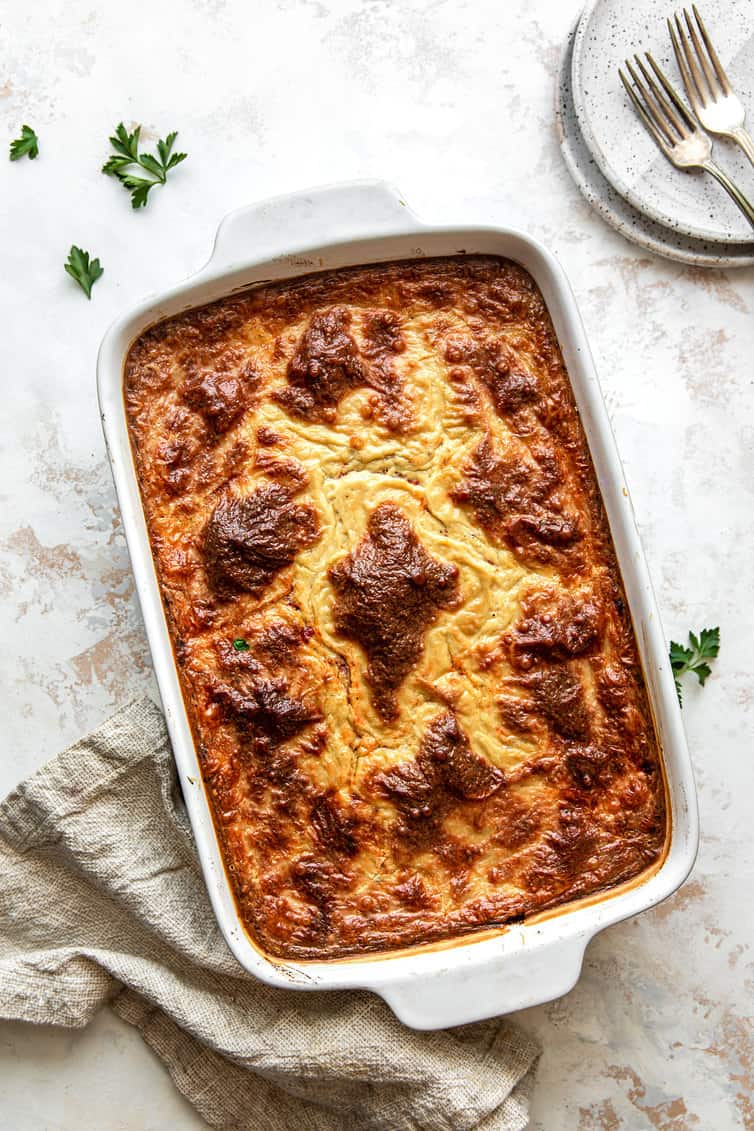
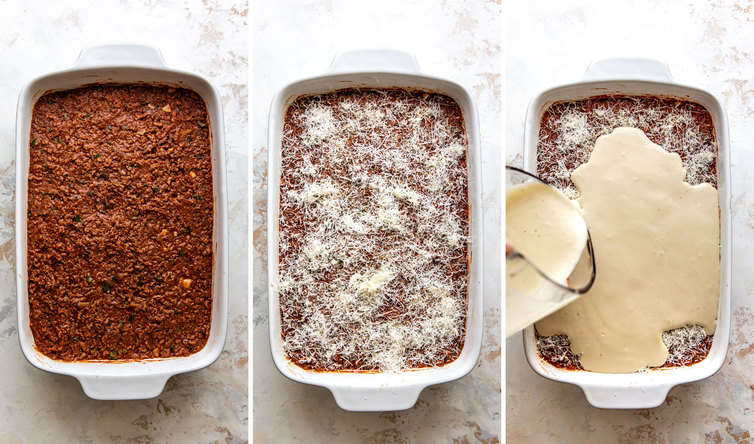
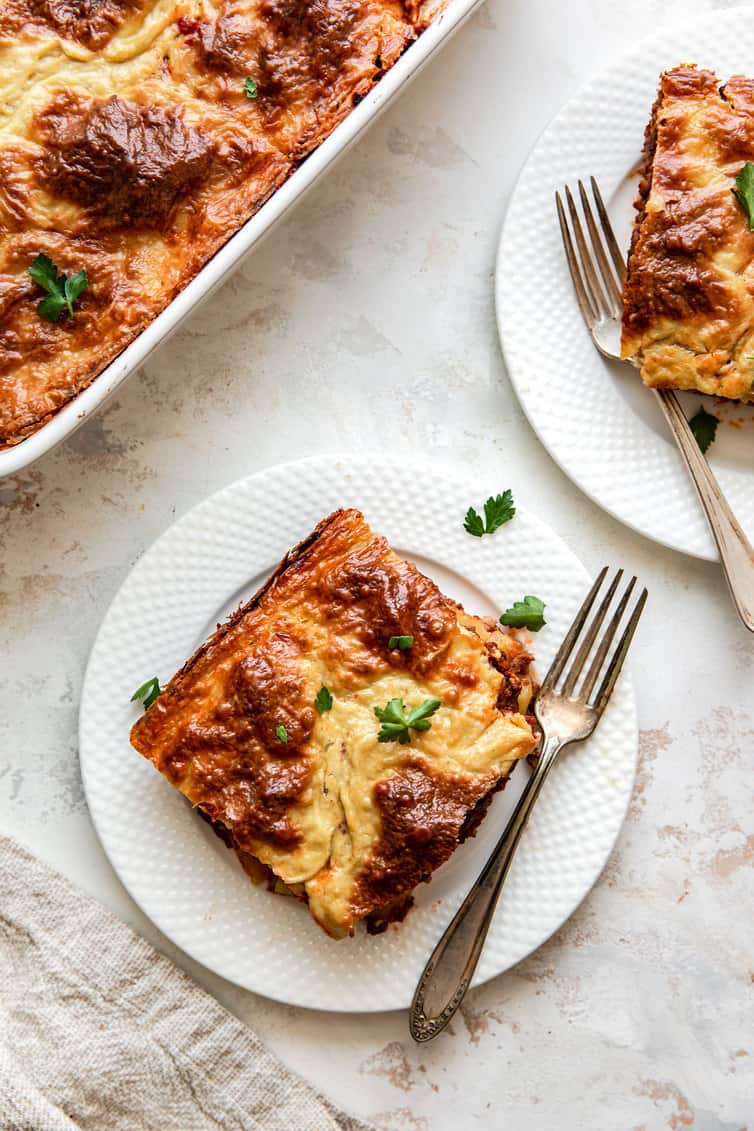




Honestly thank you so much for your page. I’ve perused all kinds of topics on your channel, and I always thoroughly enjoy all of your content.
Although, I did not prepare this Moussaka recipe because I was out of ingredients. After I preparing and tasting it today, I must confess it taste amazing just as when I tasted your Pound Cake, that was brilliant. And I must say, after following your Perfect Cream Cheese Pound Cake recipe, I have been scavenging your blog for more ideas, and they have been very delicious. Thanks, Michelle, I am so grateful. Happy Holidays.
I am so excited about your posting of Moussaka. Have been to Greece…loved moussaka there. Our area had a Greek restaurant which served authentic Greek entrees…it’s gone. Now I can try making my own!!
Thank you!!
Hi Michelle, I have been making Greek Moussaka for years. I got the recipe from my brother’s first wife. She was working as a belly dancer in Greek restaurant and got the recipe from the owner.. I use all eggplant and ground lamb no potatoes. The bechamel sauce is about the same. Love the recipe. Next time I make the recipe I might try using potatoes and carrots.. The recipe is always gets rave comments. Always like hearing about you and the family and good recipes. Happy Holidays.
I just put my moussaka in the oven – can’t wait for the 50 minutes to pass. I did use ground lamb instead of the beef, just because I grew up on a sheep farm and I just love a lamb moussaka. Thanks for the recipe and the inspiration (and your lovely pictures of the perfectly cut slice).
Years ago I took a holiday to Greece n fell in love with their food! I am so excited to make this at home. It’s one of my favourite places in the world with some of my favourite dishes! Thanks for sharing it with us!
One of my all time favourite meals ! This recipe looks so authentic and delicious. In my college days, we used to frequent an out of the way Greek restaurant, where they provided plates to smash in the traditional dancing. What fun it was, good times, and where my love for this dish was created. I haven’t found a recipe to match my memories, but this one sounds spot on. I will surely be making this for my family soon !
Made this and loved it! Worth the time, and my kids loved it too! I added a bit more garlic, salt and pepper. Next time I will add a bit more allspice to the meat. This recipe is a keeper!
By “tomato puree” do you mean tomato sauce or crushed tomatoes or something else completely?
Hi Ashley, Tomato puree is an actual product, found where the canned tomatoes, crushed tomatoes, tomato paste, etc. are located in the grocery store. http://contadina.com/products/puree-tomato.aspx
Always looking to try new recipes and new ideas… never made moussaka before, but I am always up to try something new!
It’s all right. Luckily, I managed to figure out what went where, eventually :) My family loved the dish, and everybody kept emphasizing how tasty it was (you know how it is with people for whom you cook on a regular basis – if they say anything nice about their dinner, then it’s probably marvelous). Well worth the effort, indeed.
Just made it!! I assumed you put the egg white and parsely in the meat mixture right before you started doing the layers in the lasanga dish, so that’s what I ended up doing (they weren’t listed in the instructions). It’s okay though! It turned out perfect, my family loved it! My dad and sister weren’t really sure about it at first, but they loved it and thought I should add it to our rotation (I’m 16, and usually make dinner for my family, your site helps a lot!)..! I started really early so I could give myself some times to do all the prep, plus I knew there was an extra 50 minutes of cooking and 15 minutes (I could only waited 10 minutes, my family couldn’t wait longer… me either) of cooling, so I was prepared. Your layers definitely turned out better then mine, plus I think I cut my potatoes too thick, BUT it photographed well (similar to a lasagna I guess) and tasted great. Thanks again for the fantastic recipe!
Hi Jenny, I apologize for the error in the recipe; I have since fixed it, but you are correct – the egg white and parsley went into the beef mixture. I’m so happy to hear that you and your family enjoyed the moussaka!
I have to say that this recipe was a bit sloppy :( My moussaka was halfway done when I realized that the list of ingredients mentioned “1 egg white” and “5 tablespoons chopped parsley” without saying where they go (and people had already asked about that in the comments). I frantically googled other moussaka recipes, and found one that looked very similar. According to that one, the parsley goes into the meat-and-tomato mixture. When the mixture is ready, it should be put aside to cool, and then the beaten egg white should be added to the meat (I cannot be too hot, so the egg white wouldn’t cook!).
Also: the white sauce took forever to thicken, more like 30 minutes than 20. I suspect it might have had too little flour – I usually add one heaping tablespoon per one glass of milk when I’m making the Bechamel sauce.
Hi Morri, My apologies for the issue with the egg white and parsley. I have edited the recipe so it is now correct, but yes, it does go into the meat mixture.
I have to say that this recipe was a bit sloppy :-( I decided to make the moussaka without reviewing the instructions carefully first – BIG mistake. My moussaka was halfway done, when I realized that the list of ingredients mentions “1 egg white, lightly beaten” and “5 tablespoons finely chopped fresh parsley” without saying where they go (and I saw that other people had already asked about that in the comments). I frantically googled some other recipes, and found one that looked very similar. According to that one, the parsley is added to the meat-and-tomato mixture. After the mixture is ready, it should be put aside to cool, and then the beaten egg white should be mixed into the meat (it cannot be too hot, so the egg white would not cook!)
And another thing: the white sauce took forever to thicken – way over 20 minutes and closer to 30. I suspect that it was the shortage of flour; I usually add one heaping tablespoon per one glass of milk when I make the Béchamel sauce.
I’ve never tried mousakka before but this recipe sounds really yummy!
Never had moussaka before, but I’m really tempted to give a shot at this one. It look mouth-watering and gives me a warm homely feeling. Gonna make it soon!
P.S : I love your blog. You inspire me so much. Look forward to your new posts every single time. Lots of love. :D
where does the one egg white fit in??
Hi Jana, The egg white gets folded into the beef mixture. I apologize for the omission; the recipe has been updated and now includes those directions.
Your recipes are always so enticing. I am going out tomorrow morning and buying some eggplant. I’ve made moussaka before but it didn’t have a layer of potatoes. I think they will sop up some of the grease from the meat and the eggplant. My last attempt was a little too greasy. I keep kosher and will use milk substitute in the bechamel and skip the Parmesan but I’m sure it will be great. You listed one egg white and some parsley in the ingredients and I don’t see where they are added in the instructions. Can you please clarify!
Hi there, My apologies for the oversight – the egg white and parsley get folded into the ground beef mixture. I have edited the recipe above to clarify. Enjoy!
Thanks for the info. I made it a few days ago (couldn’t wait) and I figured the egg white and parsley got mixed into the meat. I did wait for the meat to cool so it wouldn’t scramble the whites. It is in the freezer waiting for me to make the white sauce before baking. I have to decide which non dairy products to substitute for the milk and heavy cream.
This sounds delicious! I wonder if it would be any good with ground turkey instead of beef?
Hi Vicki, I don’t see why not. I used pretty lean ground beef; with all of the flavor and moisture, I think you could use ground turkey and not lose too much flavor.
What is the name of the Greek restaurant and where in DC is it? My husband and I go to a FABULOUS Greek restaurant in Old Town Alexandria.
Hi Kelly, The name of the restaurant is Vasilis. It’s in Gaithersburg, MD in the Kentlands neighborhood. Definitely try it!
Hey!Since you’re trying greek recipes ,there’s just one dessert you should definitely try, it’s called “galaktompoyreko”. One of the best Greek desserts,trust me, i’m Greek!
Oh goodness. Next thing I know, you’ll be doing a pastitsio recipe… and I might just have to curl up into a little ball of happy and die.
I have never tried moussaka, but your recipe is the 1st I’ve ever seen that tempts me to try making it. I’ve been craving lasagna and this seems to be just a side step dish from traditional lasagna. :)
I’ve been wanting to try this ever since I moved to Europe!! :D maybe I’ll try this one :B
I’ve had moussaka at a diner and liked it but this one looks heavenly!
i’ve never had moussaka, looks delicious but always reminds me of that old SNL skit…. ;)
Greek, cheesy, potatoes, bechamel sauce… Oh yeah. It’s happening for dinner tonight.
This is one of my favorite things. Ever. Fantastic recipe!!
As a Greek I have to tell you that this moussaka looks divine!! Perfectly layered and cooked! Yummy!
Is there anything you haven’t made? You inspire me! I can’t wait to see what is next! I’m an old cook looking up to a much younger one-You. Love learning from you with every post. Thanks.
This sounds fantastic. Much more interesting and flavorful than the recipe I am currently using. Can’t wait to try it!
Love the recipe and the story behind it. Looks great! It is one of my favorites too.
This is the favourite meal of my brother-in-law. Always reminds me of him! :-)
I’ve had moussaka twice….once at a Greek festival and once a a local Greek restaurant. Both times it was excellent and one of the warmest and most comfortable things ive ever eaten. I don’t know why I never thought to try to make it at home but now I have too especially with colder weather coming in. I can’t wait!
That moussaka is looking tasty! I can’t wait to make my first batch of moussaka this fall!
My favorite comfort food. Mine substitutes lamb, adds cinammon and white wine and adds parmesan to the sauce. I like that you cut the eggplant in rounds rather than planks. Sometimes i make a “lazy mans” version where i just dice it.
Love your blog!
Gary
Moussaka is my hubby’s favorite, too! He always orders it at this all natural Greek restaurant we love to go to. I definitely will have to try this…my husband thanks you in advance :)
Awwww sweet story, I love it! I’ve never actually heard of moussaka, but all of the components sound wonderful. It seems like the perfect comfort food!
Moussaka is also a big favorite of ours but I’ve never attempted it at home. Every time I look at a recipe for it I start to think it’s too tedious and then Brian says lets go to the Greek restaurant and order it there and I say OK. :)